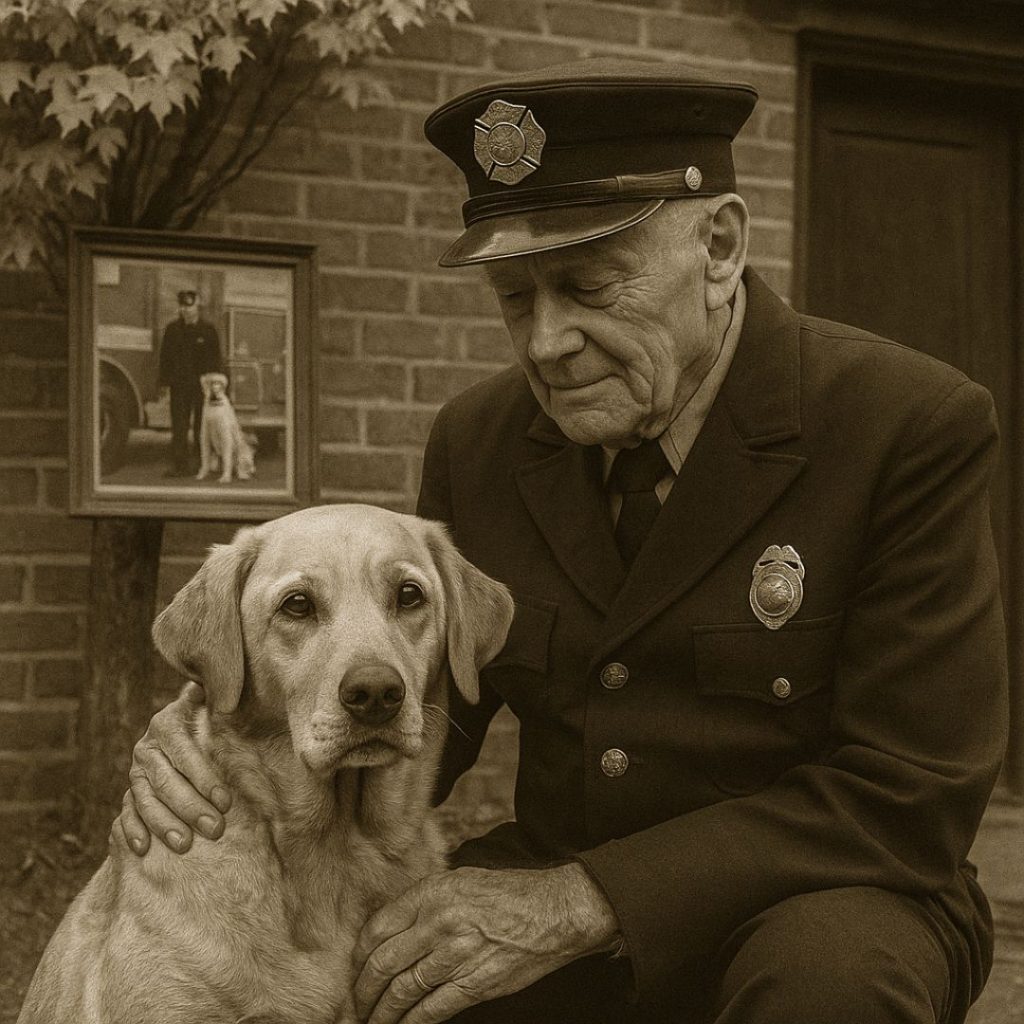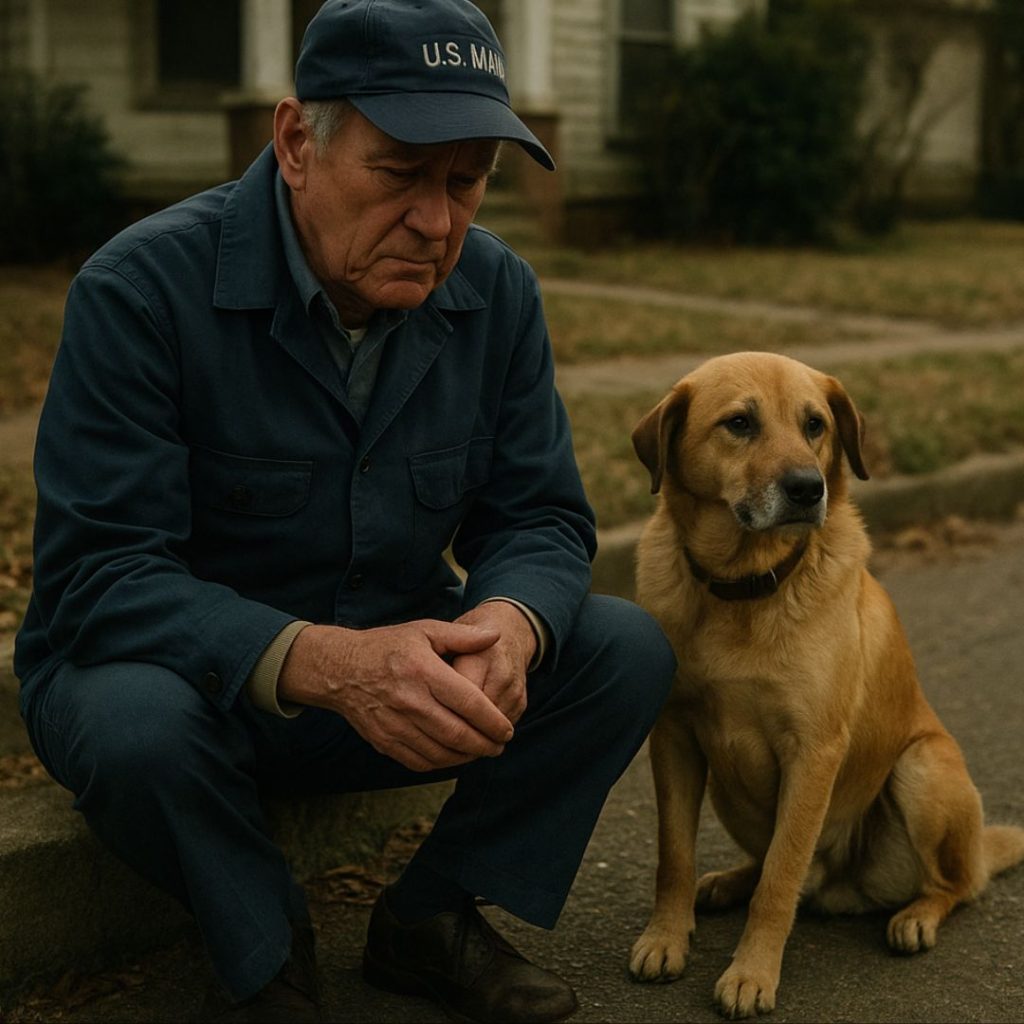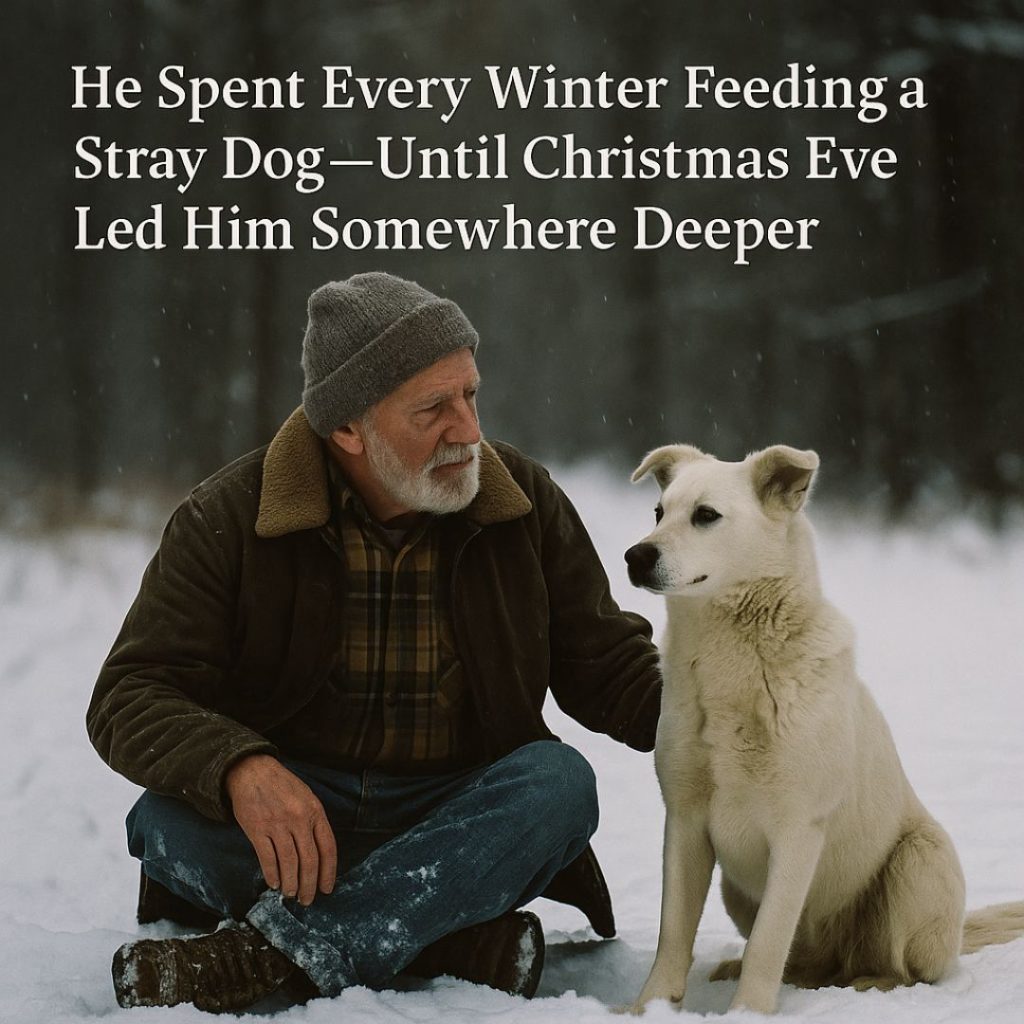Every time the siren howls, he still hears the past calling.
A retired firefighter, a puppy pulled from the ashes, and a bond forged in flame.
Now, years later, they walk into classrooms instead of burning buildings—carrying stories the world forgot.
But not every scar is visible.
And some heroes bark.
📖 Part 1: The Ember That Lived
My name is Thomas “Tommy” Greaves. I live on the corner of Maple and 3rd, in a small yellow house with red shutters and an American flag that’s been there since the day I retired.
Thirty years in the Wilmington Fire Department. Twenty-eight fires that almost took my life. And one that changed it forever.
It happened on a bitter February night in 2012. An old tenement on Porter Street went up like matchsticks. Poor wiring, dry walls, and a blizzard that slowed every truck in the city. We didn’t think anyone was still inside—until we heard the whimpers.
The mother dog was gone by the time we found her. Curled over her litter in the back of a scorched closet. Most of the puppies were already gone, too—just tiny soot-stained bundles.
But one moved.
He was the runt. Fur blackened with ash, ribs showing through his fragile frame, but alive. I remember lifting him into my coat, not caring about regulations or reports. I just knew he was mine.
I called him Ember.
That night, after the blaze was out and the gear was off, I sat alone in the cab of Engine 3, cradling a trembling pup in a towel. He didn’t make a sound. Just stared at me with eyes too wide for his body. Eyes that had already seen too much.
I was nearing retirement by then. The firehouse smelled like old coffee and turnout gear. My knees popped when I climbed stairs. The young guys called me “Cap” out of respect, though I’d been off captain rank for years.
But Ember made me feel young again.
At first, he was just a shadow. Followed me everywhere. Slept in my boots. Cried when I left for a shift. The guys at the house joked he’d be sliding down poles next.
We trained him slow. Gentle. No loud noises. No sudden movements. I built trust with treats and time.
By his second birthday, Ember was visiting local schools with me during fire safety week. At first, the kids just liked seeing a dog in a fire hat. But then Ember started doing something I didn’t expect—he’d pick out the quietest child in the room and lay at their feet.
Like he knew which ones were scared. Which ones needed a friend.
We became a team.
I retired officially in 2015. Gave my helmet to the rookie who reminded me most of myself. Packed up my locker. Took home a coffee mug full of coins and a photo of my old crew in front of a burning barn.
Ember came with me, of course. By then, he had a scar on his left paw where the fire got too close one day. I used to rub it when I told him stories. He’d thump his tail like he remembered.
We weren’t done.
There’s a program called Junior Shield that runs in the Wilmington School District. Teaches fire safety through visits from veterans like me. I signed up the month after retirement. Ember got a vest and a laminated ID badge with a little paw print on it.
We’d walk into classrooms—me with my smoky voice and him with his slow, proud gait. I’d tell stories. Show them a burnt piece of drywall. Ember would roll over on command or bark twice when I said, “What do we do if we smell smoke?”
He was always the star.
One fall morning in 2018, we visited Grover Elementary on the north side. It was the first time I met Principal Holloway, a tall woman with soft eyes and a handshake that could crush bones. She said, “Captain Greaves, we’ve been waiting for you.”
They weren’t ready for Ember.
He did something strange that day. During story time, he walked to the back of the classroom and sat beside a boy named Jordan. Just sat. Didn’t wag. Didn’t move.
Jordan didn’t talk to anyone. He wore sleeves too long and flinched when the bell rang.
When Ember nudged his hand, the whole room froze.
Then Jordan smiled.
Later, the teacher told me Jordan had been in a house fire the year before. Lost his stepdad. Slept with a flashlight under his pillow. That day was the first time he’d laughed in months.
I didn’t tell anyone, but I cried in the truck on the way home.
That’s when I realized Ember wasn’t just a survivor.
He was a healer.
📖 Part 2: Sparks That Stay
I still remember the way Ember looked at me in the rearview mirror that day after Grover Elementary.
Not like a dog, but like a fellow old soul.
Like he understood something I didn’t.
We stopped by Murphy’s Diner on 5th and Charles, the kind of place where the coffee’s bad and the gossip is better. I ordered my usual—meatloaf sandwich, side of slaw, and a black coffee with enough sugar to wake the dead. Ember got a few pieces of turkey from Eileen, the waitress who called him “Chief” ever since he wore that little red helmet.
He sat under the booth like always, head on his paws, eyes on the door. Watching. Always watching.
“Tommy,” Eileen said, leaning on the counter, “that dog of yours is more human than half the folks I serve.”
I smiled, but I didn’t argue. Because she was right.
When I got home that night, I opened my old fireproof lockbox. The one I kept tucked behind the coats in the hall closet. Inside were clippings, photos, my first badge, and one small charred collar from the Porter Street fire. I hadn’t looked at it in years.
It still smelled like smoke.
I pressed it against my palm, let the past wash over me.
The screams.
The heat.
The feeling of holding something so small and fragile and promising.
Ember was lying nearby, watching.
I held the collar up, and he sniffed it, then laid his head back down.
Like he knew.
That weekend, we got a call from the Junior Shield coordinator.
“Captain Greaves, we’re starting a new initiative—rural schools, first-time visits, low funding. You and Ember up for a few extra miles?”
I didn’t hesitate.
Our first stop was a two-room schoolhouse in Stanly County, tucked between soybean fields and winding gravel roads. Kids there had never seen a fire truck up close. Some didn’t even know what a smoke detector sounded like.
We brought Ember’s vest, my old gear bag, and a plastic smoke alarm I’d rigged to beep on cue. When the alarm chirped, most of the kids jumped.
Except one.
A girl named Cassidy.
Freckles. Red hair. Small for her age.
She stood up, walked right over to Ember, and asked, “Does he remember the fire?”
I blinked. “What fire, sweetheart?”
She looked down. “The one I had.”
Turns out her family’s trailer had burned down last year. No injuries—but they lost everything. Ember leaned into her. Just leaned. And she wrapped her arms around his neck and stayed there.
Didn’t cry.
Didn’t talk.
Just held on.
That night, I sat on the porch of a tiny roadside motel. One of those places where the doors face the parking lot and the air smells like pine cleaner. Ember lay beside me, his head on my boot, watching moths swirl under the orange porch light.
I scratched behind his ear. “You’ve got more purpose left in you than I do, boy.”
He blinked slow. The way old dogs do. The way old firefighters do.
The next few months blurred into a rhythm.
We drove.
We taught.
We healed.
One town after another. One story after another.
At Greenbriar Middle, a kid raised his hand and asked, “What’s the worst fire you ever saw?”
I started to tell him about the warehouse blaze back in ‘98—when the roof collapsed and pinned two men inside. But Ember let out a soft whine.
Instead, I told them about a fire that didn’t take lives—but changed one.
Porter Street.
The mother dog.
The runt who refused to quit.
The room fell silent. Even the teachers stopped rustling papers.
Ember stood up, walked to the front of the class, and sat beside me.
No tricks. No commands. Just sat.
Like he wanted them to see.
Like he needed them to know.
After that visit, a group of students sent us drawings—Ember in a firetruck, Ember barking at smoke, Ember with a superhero cape. I pinned every one of them on the corkboard in my hallway.
But something had changed.
He started moving slower.
Getting up took longer.
The old scar on his paw bothered him more when it rained.
He still wagged his tail when I grabbed his vest. Still barked once when I said, “Ready to go, partner?”
But I could see it.
Time was catching up.
One cold morning in February—six years to the day since I carried him from that closet—I found Ember standing in front of the door, vest already in his mouth.
I hadn’t even said a word.
We were scheduled for a visit at St. Mary’s, a Catholic school where most of the kids came from refugee families. I’d been nervous about this one. Many didn’t speak English yet. Some had survived real trauma—war, loss, firebombings.
What could I say to reach them?
Turns out, I didn’t have to say much.
As soon as we walked in, the kids lit up.
Not because of me.
Because of him.
Ember walked slowly but proudly. One boy reached out, and Ember stopped, let the child rest his forehead against his. No words were exchanged.
But none were needed.
That day, I didn’t tell stories. I just watched.
Watched Ember heal children who didn’t know what healing was.
Watched a dog with old bones and quiet eyes become the loudest voice in the room.
On the drive home, he curled up tighter than usual.
Didn’t even lift his head at the diner when Eileen brought turkey scraps.
I knew what it meant.
He’d given all he had that day.
But there was still one more visit we had to make.
One I’d been putting off for years.
The old firehouse on Porter Street.
The place where it all began.


